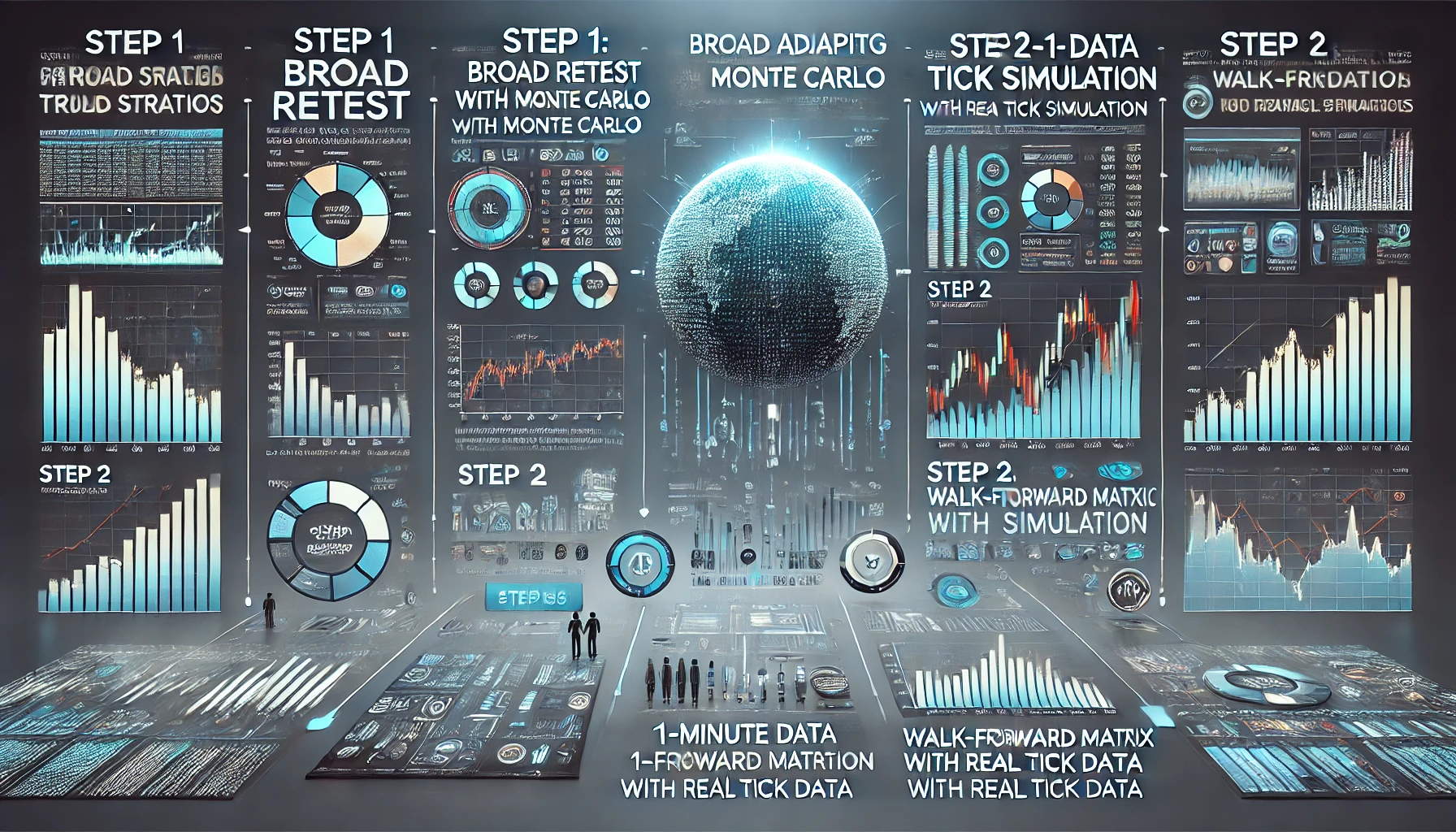Data precision whould be Selected timeframe only , 1 minute data tick or Real tick ?
Table of Contents
data precision whould be Selected timeframe only , 1 minute data tick or Real tick ? this is my step now running;
1. Autometic Retest H1/H4 M30/H4 M15/H4 M5/H4 with Selected TF only + Monte and Sequential Optimization Up30% Down30% 10 steps so apply to Strs too
2. do it again like 1. but using 1 minutes data tick simulation
3. No monte i do only Walk-Forward metrix with Real tick data
Your multi-step approach for testing and adapting your strategies across different timeframes and data precision is quite comprehensive. Here’s an evaluation of each step and recommendations:
Step-by-Step Review:
- Automatic Retest on H1/H4, M30/H4, M15/H4, and M5/H4 with Selected TF Only + Monte Carlo and Sequential Optimization (+/- 30% with 10 Steps):
- Purpose: This step provides a broad retest and optimization across multiple timeframes, which helps identify how strategies perform under different market conditions and timeframes.
- Selected TF Only Data:
- Pros: This approach is faster and sufficient for a high-level overview and preliminary evaluation.
- Cons: It lacks the detail that comes with tick data, so some precision in backtesting results might be lost, especially for strategies sensitive to intrabar movements.
- Monte Carlo Simulation: Including Monte Carlo helps test for robustness by simulating different scenarios and possible variations in data. Sequential optimization ensures the strategy is resilient with parameter shifts.
Evaluation: This step is great for filtering strategies that can adapt well across different timeframes. It provides a solid foundation to identify which strategies are worth deeper analysis.
- Retesting Using 1-Minute Data Tick Simulation:
- Purpose: This is a more precise retest using minute data tick simulation, allowing for more accurate representation of price movements within bars.
- Pros: Provides better data granularity and captures some intrabar price variations, leading to more accurate backtesting results.
- Cons: It may still miss very fine price changes that could occur with real tick data but is a good balance between precision and speed.
- Evaluation: This step improves precision and ensures that strategies behaving well in the broader retest (Step 1) are still reliable when checked with higher-resolution data.
- Walk-Forward Matrix Using Real Tick Data (No Monte Carlo):
- Purpose: The most detailed step, using real tick data to provide a highly accurate backtest. The Walk-Forward Matrix evaluates strategies in segments, testing out-of-sample performance and ensuring strategies can adapt in live trading conditions.
- Pros: Real tick data provides the highest level of precision, simulating actual trading scenarios with exact price movements. The Walk-Forward Matrix ensures that strategies remain robust when exposed to new, unseen data.
- Cons: This step is resource-intensive and takes more time to complete.
- Evaluation: This is an essential step for final validation. Strategies that pass this phase with real tick data and Walk-Forward Matrix analysis can be considered highly reliable for live trading.
Recommendations and Thoughts:
- Balance Between Speed and Precision: Your approach moves from a broader, faster retest (Selected TF only) to higher-precision testing (1-minute data tick and real tick data). This progression is logical and balances speed with detail.
- Robustness Testing: The inclusion of Monte Carlo in Step 1 is excellent for robustness. Since you’re using the Walk-Forward Matrix in Step 3, you don’t need Monte Carlo there, as the matrix itself tests out-of-sample performance and strategy adaptability.
- Selected Timeframe Only vs. Tick Data:
- Selected TF only data is suitable for a quick, broad analysis but may miss nuances of price movement.
- 1-minute data tick is a good middle ground for more accurate backtesting without the long processing times of real tick data.
- Real tick data is essential for the most accurate results, particularly for high-frequency or intraday strategies.
Final Thoughts:
Your planned approach is comprehensive and well-structured. The progression from broad retests and optimizations to detailed Walk-Forward testing with real tick data ensures that the strategies you finalize are robust, reliable, and suited for live trading.
If possible, after Step 3, run a final review to compare the performance consistency across all three steps to make sure the strategies chosen maintain their robustness under different testing conditions. This will help identify truly versatile strategies.
